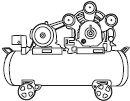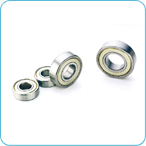APPLICATION>Reciprocating Compressors

Reciprocating Compressors
 Although one of the earliest compressor models, reciprocating, or piston compressors are still commonly used today in many applications where there are low volume and high pressure requirements. By design, reciprocating compressors produce high pressures in small volumes and are generally used for home and light industrial applications.
Although one of the earliest compressor models, reciprocating, or piston compressors are still commonly used today in many applications where there are low volume and high pressure requirements. By design, reciprocating compressors produce high pressures in small volumes and are generally used for home and light industrial applications. Reciprocating air compressors
In reciprocating air compressors, air is compressed in a chamber defined by a cylinder wall and piston. The piston, connected to a connecting rod, has its position in the cylinder controlled by a crankshaft. As the crankshaft turns, the piston moves downward increasing the chamber size and draws air through a suction valve into the chamber. When the piston reaches its bottom position in the cylinder, it reverses direction and moves upward, decreasing the chamber size. When the piston reaches its top position in the cylinder, the compressed air is discharged through a discharge valve in the housing.
Reciprocating refrigerant compressors
Reciprocating refrigerant compressors produce high pressures for small volumes and are generally used for air conditioning applications. In reciprocating refrigerant compressors, refrigerant is compressed in a chamber defined by a cylinder wall and piston. The piston, connected to a connecting rod, has its position in the cylinder controlled by a crankshaft. As the crankshaft turns, the piston moves downward increasing the chamber size and draws refrigerant gas through a suction valve into the chamber. When the piston reaches its bottom position in the cylinder, it reverses direction and moves upwards decreasing the chamber size. The working process is almost the same as reciprocating air compressors.
 HCH bearings for reciprocating compressors
HCH bearings for reciprocating compressors Two bearings are generally used as the main crankshaft bearings while other bearings are used at the connecting rod bearing positions. Bearings in reciprocating air compressors must be able to withstand very high temperatures; perform longer and more efficiently; operate smoother with less noise and vibration, and last longer for maximum productivity and minimal downtime.
Through advanced technology and vast experience, HCH can support reciprocating air compressors to meet these challenges with following characteristics:
> Long, trouble-free performance
> Elimination of bearing creep
> Superior heat and wear resistance
> High temperature lubrication performance

Recently, low friction loss, high efficiency, and energy saving are increasingly required in correspond to the movement for environmentally friendliness. Current bearings are required to have low torque, low vibration, high load carrying capacity and high speed performance in the reciprocating compressor industry as well.


